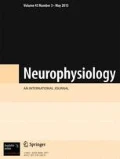Under conditions of the open field test, 30 control Wistar rats and 30 rats with experimental cardiomyopathy (CMP) were examined with recording of four behavioral indices, (i) number of crossed squares (intensity of locomotion), (ii) number of rearings (vertical stands), (iii) number of examined holes in the arena, and (iv) number of grooming episodes, within a 28-day-long observation period. The CMP state was induced by five i.p. injections of 5.0 mg/kg of doxorubicin with one-week-long intervals. As was found, all behavioral indices of control rats demonstrated considerable (sometime statistically significant) variations within the observation period (this fact has probably attracted insufficient attention in analogous experiments with long-lasting observation periods). The development of doxorubicininduced CMP resulted in considerable suppression of all types of behavioral activity, relatively moderate within the first week of observation and dramatic within late phases of the observation period. The dynamics of the numbers of rearings and grooming phenomena were complex, with noticeable increases on days 3 and 14. The dynamics of the numbers of rearings and inspection of the holes in both experimental groups were significantly dissimilar, which indicates that these behavioral phenomena are related to different aspects of the research/orientatinal activity. In general, a state of increased anxiety followed by the development of a depression-like state was observed in CMP rats. These negative shifts in behavioral activity are believed to result from general CMP-induced insufficiency of blood supply of the brain and development of hypoxia in the latter; specific direct effects of doxorubicin on some cerebral structures seem to be unlikely.
Similar content being viewed by others
References
V. M. Kovalenko and V. M. Kornatskii, Dynamics of the State of Health of Ukrainian Population and Regional Peculiarities (Analytical/Statistical Manual), Kyiv (2012).
G. S. Galyautdinov and M. A. Lonkin, “Cognitive disorders at chronic cardiac insufficiency,” Vest. Sovr. Klin. Med., 8, No. 1, 69-77 (2015).
B. Haring, A. Omidpanah, A. M. Suchy-Dicey, et al., “Left ventricular mass, brain magnetic resonance imaging, and cognitive performance: results from the strong heart study,” Hypertension, 5, 964-971 (2017).
Yu. V. Kozlova, “Modern concepts on the cardiocerebral pathology (pathogenetic mechanisms of brain demage at heart diseases), Tavr. Med. Biol. Vest., 15, No. 3, 132-136 (2012).
V. P. Pishak, V. G. Vysots’ka, V. M. Magalyas, et al., Laboratory Animals in Medical/Biological Experiments, MedUniversity, Chernivtsy (2006).
L. M. Nepomnyashchikh, Ye. L. Lushnikova, M. G. Kalinnikova, et al., “Effect of doxorubicin on dilatational remodeling of myocardium within a period of progressive growing,” Sib. Med. Zh., 26, No. 4, 147-151 (2011).
A. M. Hooghiemstra, A. S. Bertens, A. E. Leeuwis, et al., “The missing link in the pathophysiology of vascular cognitive impairment: design of the heart-brain study. Heart-brain connection consortium”, Cerebrovasc. Dis. Extra, 7, No 3,140-152 (2017).
A. G. Rodinskii and Yu. V. Kozlova, “Dynamics of changes in the structure of the hippocampus under conditions of myocardial dysfunction,” Morfologiya, 9, № 2, 62-68 (2015).
Preclinical Examination of Medicines: Methodical Recommendations, A. V. Stefanov, ed., Avitsenna, Kyiv (2002).
J Bureš, O. Burešova, and J. P. Huston, Techniques and Basic Experiments for the Study of Brain and Behavior [in Russian], Vyssh. Skola, Moscow (1991).
A. V. Kaluyev, Stress, Anxiety, and Behavior. Urgent Problems of Modeling of Anxiety-Related Behavior in Aminals, Kyiv (1998).
K. M. Skubitz, A. H. Blaes, S. H. Konety et al., “Cardiac safety profile of patients receiving high cumulative doses of pegylated-liposomal doxorubicin: use of left ventricular ejection fraction is of unproven value,” Cancer Chemother. Pharmacol. 80, No 4,787-798 (2017).
M. Nabati, G. Janbabai, S. Baghyari et al., “Cardioprotective effects of carvedilol in inhibiting doxorubicininduced cardiotoxicity,” J. Cardiovasc. Pharmacol., 69, No 5, 279-285 (2017).
N. Chahine, J. Hanna, H. Makhlouf et al., “Protective effect of saffron extract against doxorubicin cardiotoxicity in isolated rabbit heart,” Pharm. Biol., 51, No 12, 1564-71 (2013).
J. R. Caldas, R. B. Panerai, V. J. Haunton et al., “Cerebral blood flow autoregulation in ischemic heart failure,” J. Physiol. Regul. Integr. Comp. Physiol., 312, No 1, R108-R113 (2017).
A. A. Solkin, N. N. Belyavskii, V. I. Kusnetsov, et al., “Main mechanisms of the brain formation at adaptation to hypoxia,” Vestn. VGMU, 11, No. 1, 6-14 (2012).
E. M. Brekke, T. S. Morken, M. Widerøe et al., “The pentose phosphate pathway and pyruvate carboxylation after neonatal hypoxic-ischemic brain injury,” Cereb. Blood Flow Metab., 34, No 4, 724-34 (2014).
V. Guz’, V. S. Nedzvets’kii, P. O. Nerush, et al., “Effect of hyperthyroidism on the memory and state of glial intermediate filaments in the rat brain,” in Proc. V Nation. Congr. Pathophysiol. Ukraine (Zaporizhzhya), 5, No. 3, 20 (2008).
M. Buyuklu, F. M. Kandemir, T. Set et al., “Beneficial effects of ozone therapy on oxidative stress, cardiac functions and clinical findings in patients with heart failure reduced ejection fraction,” Cardiovasc. Toxicol., 17, No 4, 426-433 (2017).
O. V. Torkunova, A. A. Bayramov, ad P. D. Shabanov, “Cholinergic modulation and neurochemical aspects of congenital behavior of rats upon action of low-frequency acoustic oscillations,” Obz. Klin. Farm. Lek. Toksikol., 30, No 1, 32-40 (2015).
Author information
Authors and Affiliations
Corresponding author
Rights and permissions
About this article
Cite this article
Rodynskii, O.G., Kozlova, Y.V., Kozlov, S.V. et al. Doxorubicin-Induced Cardiomyopathy in Rats: Behavior of the Animals in the Open Field. Neurophysiology 50, 259–265 (2018). https://doi.org/10.1007/s11062-018-9747-x
Received:
Published:
Issue Date:
DOI: https://doi.org/10.1007/s11062-018-9747-x


